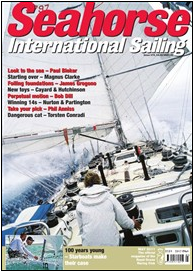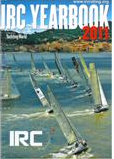 Rule Changes
Rule Changes
Following consultation and agreement with the IRC Policy Steering Group, the IRC Technical Committee has decided that the following changes to IRC Rules for 2010 and 2011 will take effect from 00:01 on Monday 20th December 2010.
The substantive effect of the changes below is that FL and J are always measured to the permanent forestay. In addition, it is clarified that a headsail may be hoisted and tacked from outside the foretriangle.
Insert:
The ERS definition of Forestay shall not apply.Forestay is defined as:
Forestay: Permanently attached rigging providing forward support for a mast spar. References throughout IRC Rules and Definitions to forestay are replaced by forestay.
Delete:
FL The forestay length measured from the forward end of J to the higher of either:
(a) the forestay rigging point, or:
(b) if a headsail may be set forward of the forestay, the intersection of the spar
and the lower edge of the halyard used to hoist the headsail, when at 900 to the spar, extended as necessary.
Replace: FL
The forestay length measured from the forward end of J to the forestay rigging point.
Delete: J
The longitudinal distance between the intersection of the fore side of the mast spar, extended as necessary, and the deck including any superstructure; and the most forward point on the deck, or a centreline bowsprit spar, to which a headsail may be tacked, projected if necessary.
Replace: J
The longitudinal distance between the intersection of the fore side of the mast spar, extended as necessary, and the deck including any superstructure; and the intersection of the centreline of the forestay, extended as necessary, and the deck, or bowsprit spar.
Delete 21.3.3
RRS 50.3(a) is amended to the extent that a spinnaker may be tacked to a bowsprit. A headsail may only be tacked to a bowsprit if J and FL are measured to the headsail tack attachment point on the bowsprit. See the definitions of J and FL.
Replace: 21.3.3
RRS 50.3(a) is amended to the extent that a spinnaker or a headsail may be tacked to a bowsprit.
Delete: Headsail
RRS 50.4 shall not apply. Any sail tacked down forward of the foremost mast which does not meet the definition of a spinnaker.
Replace: Headsail
RRS 50.4 shall not apply. Any sail tacked down forward of the foremost mast which does not meet the definition of a spinnaker. A headsail may be hoisted from above the forestay rigging point.
Delete: LP
The luff perpendicular of the largest area headsail on board and which may be used while racing. For a cutter rig, LP is measured as the shortest distance from the aftmost clew point of any headsail when set on the centre line of the boat, to the foremost forestay.
Replace: LP
The luff perpendicular of the largest area headsail on board and which may be used while racing. For a cutter rig, LP is measured as the shortest distance from the aftmost clew point of any headsail when set on the centre line of the boat, to the foremost headsail luff which may be set while racing.
Note:
Boats which may set more than one headsail simultaneously shall measure LP in accordance with the cutter rig LP definition.
 Wednesday, May 18, 2011 at 9:49PM
Wednesday, May 18, 2011 at 9:49PM  Processing of 2011 certificates are now well underway with the first event of the new year, Sawadee.com Regatta - Samui less than 2 weeks away.
Processing of 2011 certificates are now well underway with the first event of the new year, Sawadee.com Regatta - Samui less than 2 weeks away. For yachts with existing 2009 and 2010 certificates, renewal forms are now available in either Word or pdf format from the download section.
For yachts with existing 2009 and 2010 certificates, renewal forms are now available in either Word or pdf format from the download section.


